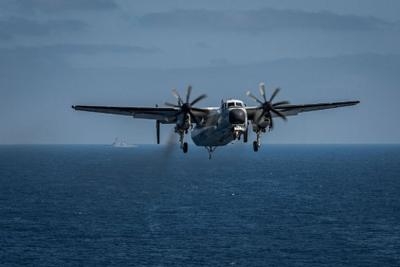Thu, Feb 22, 2018
Aircraft Went Down In The Philippine Sea In November
A Navy-led mission aboard research vessel RV Petrel has mapped the wreckage of a C-2A Greyhound aircraft that crashed into the Philippine Sea en route to USS Ronald Reagan, Nov. 22, 2017.

Using the vessel's side scan sonar and remote operated vehicle (ROV) to survey the aircraft from Feb. 2-5, the team determined the aircraft lies on the ocean floor in two main sections, cockpit and fuselage, and that the C-2A's flight recorder or black box is still intact.
Planning continues for an upcoming salvage mission, during which every effort will be made to bring both sections to the surface despite very challenging environmental conditions. At a depth of 18,500 feet (more than three nautical miles) this will be the deepest aircraft recovery to date and the team with have to contend with several variables including deep water rigging and weather that may affect retrieval.
The aircraft was initially discovered late last year (Dec. 29) by a U.S. Navy Supervisor of Salvage and Diving (SUPSALV) team using a towed pinger locator (TPL-25) system aboard a different contracted vessel. In January, the Navy contracted RV Petrel to support debris field mapping and inform aircraft recovery planning.
RV Petrel is a 250-foot research and exploration vessel with advanced underwater equipment and technology, making it capable of exploring to more than 3.5 miles. A team of SUPSALV personnel embarked Petrel late January and returned to the crash site.
Assigned to Fleet Logistics Support Squadron (VRC 30) forward deployed to Japan, the C-2A aircraft was carrying 11 crew and passengers when it crashed. Eight personnel were recovered immediately by U.S. Navy Helicopter Sea Combat Squadron (HSC 12). For the next three days, Ronald Reagan led combined search and rescue for three Sailors with the Japan Maritime Self Defense Force (JMSDF), covering nearly 1,000 square nautical miles before ending the search.
(Image provided with U.S. Navy news release)
More News
Aero Linx: Model Aeronautical Association of Australia MAAA clubs are about fun flying, camaraderie and community. For over 75 years, the MAAA has been Australia’s largest fl>[...]
Touchdown Zone Lighting Two rows of transverse light bars located symmetrically about the runway centerline normally at 100 foot intervals. The basic system extends 3,000 feet alon>[...]
“Discovery and innovation are central to our mission at Virgin Galactic. We’re excited to build on our successful record of facilitating scientific experiments in subor>[...]
How To Get A Story On Aero-TV News/Feature Programming How do I submit a story idea or lead to Aero-TV? If you would like to submit a story idea or lead, please contact Jim Campbel>[...]
Student Pilot Reported That During Rotation, “All Of A Sudden The Back Of The Plane Kicked To The Right..." Analysis: The student pilot reported that during rotation, “>[...]
 ANN's Daily Aero-Linx (05.02.24)
ANN's Daily Aero-Linx (05.02.24) ANN's Daily Aero-Term (05.02.24): Touchdown Zone Lighting
ANN's Daily Aero-Term (05.02.24): Touchdown Zone Lighting Aero-News: Quote of the Day (05.02.24)
Aero-News: Quote of the Day (05.02.24) ANN FAQ: Contributing To Aero-TV
ANN FAQ: Contributing To Aero-TV NTSB Final Report: Cirrus Design Corp SR20
NTSB Final Report: Cirrus Design Corp SR20



